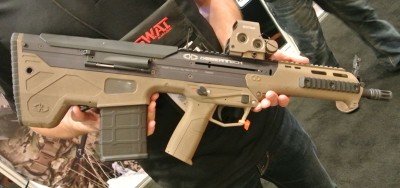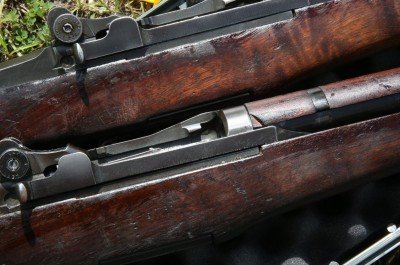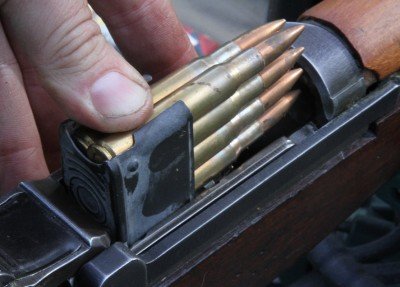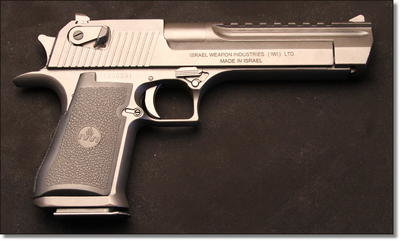By this point in the development of tactical firearms, the bullpup seems like familiar territory. Yet Desert Tech has created a good deal of buzz with the announcement of its new multi-caliber bullpup design. The company plans to release it in .223 and .308 at first, with 300 BLK, 7.62 x 39 and 6.8 SPC to follow. It will be offered with either a 10.5” or a 16” barrel. One of the most interesting design features of the new gun is a new sighting system that will allow the user to swap between calibers without losing zero. The spent casings will eject above the magazine well forward and to the right via a short chute, which is easily accessible to clear any malfunctions.
Guns
Show First
Desert Tech MDR—A Multi-caliber Bullpup is in the Works—SHOT Show 2014
BY GunsAmerica Actual Updated: January 29, 2014The Cheapest Garands – Part 3 Garands from the Government
BY Paul Helinski Updated: October 14, 2012Somehow, in preparation for the first article in this series on ordering M1 Garand rifles from the Civilian Marksmanship Program, we missed the least expensive of the bunch. They are called “Field Grade” Garands, and at $525 (plus $24.95 S&H), they seem to be a great buy. We ordered both the Springfield Armory and Harrington & Richardson (HRA) versions of these guns, and the Winchester is no longer available. Of all the Garands we have ordered from CMP so far, if you are looking for a Garand to just shoot and enjoy, you can’t do any better for the money than these field grade guns. Look around in gunshops and online and you will be hard pressed to find a nice looking and shooting Garand for under $600. Even at live auctions these days more Garands go for upwards of a thousand bucks. These “cheapest Garands” are a real find, and you order them directly from the CMP, just as we described in the first installment of this series. Our guns came in less than three weeks, each with its own hard plastic CMP case, and certification paperwork. Who knows when these guns will dry up, so if you are thinking long, heavy boxes under your Christmas tree this year, now would be the time to order.
Carlos Hathcock USMC Sniper Scope – Hi-Lux 8X Malcolm
BY Paul Helinski Updated: August 19, 2012Carlos Hathcock is probably the most famous sniper of all time. He had 93 confirmed kills in Vietnam, and until recently held the world record for a sniper shot at over 2500 yards, using a Browning M2 .50 cal. machinegun. During his entire career as a sniper, Carlos Hathcock used a U. S. Marines version of a Unertl precision riflescope. This was standard issue on his Winchester Model 70 sniper rifle, and he even used the same scope on the .50 cal. for his record shot. It is an odd scope by today’s standards. There are no internal adjustments to zero these old style Unertls. The scopes adjusts with turrets integral to the rear scope mount, and the tube of the scope floats inside adjustment pins. To buy an original of this USMC scope today would cost you thousands, but Hi-Lux/Leatherwood this past year released an exact replica, called the 8X Malcolm USMC, and the scope really great, but hard to mount. It has an MSRP of $549 and the internet and street price is slightly below that. Hi-Lux sent us one, with the mounting hardware, and we were able to have it mounted for a full range test. Our friends at the American Gunsmithing Institute (AGI) agreed to help us and you by making an instruction video on the difficult mounting process, included here, in the style of their monthly magazine and DVD subscription called GunTech that is available to their Gun Club of America gunsmith student members. If you have any interest in mounting this scope, the video will save you or your gunsmith a lot of headaches.
Garands from the Government II – The Guns Arrive
BY Paul Helinski Updated: June 24, 2012In the first installment of this series, if you missed it, I ordered six M1 Garands from the Civilian Marksmanship Program, or CMP. The premise is that now is the time to buy this historical treasures, before they dry up and get really expensive, like the 1903 Springfield has since it dried up through the CMP. There are a few details I have learned since that first article, partially from a post on the CMP forum. I wish the members had commented on our article, which was read over 45,000 times the first day it was out. So we will correct a couple things, and lets go shoot the guns!
Buying M1 Garands from the US Government – CMP – Civilian Marksmanship Program
BY Paul Helinski Updated: April 29, 2012Did you wish you bought real estate in 1999? What about gold in 2001? Well the same thing is happening right now with the rifle known as the M1 Garand, the primary battle rifle of the US throughout both WWII and Korea. On the consumer market Garands have already begun to rise in price, but what many people don’t know is that the US Government, or rather a quasi-governmental non-profit corporation who took it over from the US Army in 1996 called the Civilian Marksmanship Program, or CMP, is currently selling off what are probably the last batch of government Garands to the public. All you have to do is apply, supply the required documents, pay, and you can have a certified authentic M1 Garand shipped right to your door, in most states.
Ballistics of the Taurus Judge 2″ Poly Public Defender
BY Paul Helinski Updated: November 7, 2011
Civilian gunfights almost always happen by surprise. You could argue that in home defense situations there is sometimes a warning that a threat is imminent. You may have dogs that bark, or an alarm system that wakes you in the night, or you may think to grab a gun if a stranger knocks at your door. But daytime threats, at the gas station, at the bank, in the parking garage, in the bad neighborhood you were forced to stop for a red light, can appear from anywhere at any moment.
In such cases, if you even have the ability to defend yourself, how fast you are able to get a projectile into your attacker may mean the difference between your life and death versus those of your attacker. For this reason, the Taurus Judge series of .410 shotshell double action revolvers has gained immense popularity. While researching for this article I googled around for holster options, and many holster makers now have the Taurus Judge at the top of their list to catch the eye of interested buyers. As a defensive handgun, the Taurus Judge has eluded all speculation. The Judge has arrived.
This polymer version of the 2″ Public Defender is the most practical of the Judge line for daily carry. Though the 23 ounce gun is only 5 ounces lighter than the steel Public Defender due to a steel under-frame, the 5 ounces is a welcome reduction in a carry gun, and the plastic coated frame is completely corrosion-proof. The cylinder is blued steel, which can rust, but the Taurus finish is extremely durable and in a holster will most likely last several years with no appreciable wear.
As you can immediately tell from the pictures here, I was really curious as to the actual ballistics of the 2″ Judge with the most popular load for the gun, the Winchester PDX1 .410 shotshell. This round was created specifically for the Judge line. It contains 3 plated disks and 12 standard BB gun sized BBs. I also wanted to look at some standard 000 buck shells in .410, as well as the .45 Long Colt, which is the cartridge that has the same external dimensions as the .410 shotshell (except of course shorter) and for which all Taurus Judge revolvers are made to shoot.
If you aren’t familiar with the Judge and you are wondering how on earth a pistol can be sold as what amounts to a “sawed off shotgun” in .410 gauge, the Judge utilizes a loophole in the gun laws that specifically applies to the .410 only. Because there is a genuine firearm caliber in the same head and body size as the .410, the .45 Long Colt, there have been for generations pistols and revolvers, and even derringers, made with rifled barrels and longer chambers that can specifically handle the .410 shell. The .410 in a handgun used to be a novelty, in the occasional small production revolver and most notably in derringers, but the Judge took the concept prime time, in a reliable gun with a built in gun lock and a lifetime guarantee to boot.
Read More…
Shooting the Desert Eagle .44 Magnum
BY Paul Helinski Updated: October 9, 2011Do you want a shock? If you have an Android phone, go into the Marketplace and search for the word “guns.” Hundreds of apps will appear relating to every angle on guns and shooting you can imagine. What I found interesting was that by far the most common picture of a gun chosen for the thumbnail is none other than the Desert Eagle. As guns go, the Desert Eagle is not that common, but maybe due to video games, or movies, or just plain old coolness, it is one of the most notorious guns of all time.
Most people think of the Desert Eagle in the most famous .50AE (Action Express) caliber, but when it comes to actually buying a gun to shoot, I would suggest the far more affordable .44 Magnum. Brass is plentiful, and you can buy the ammo on the shelf at Wal-Mart or Bass Pro Shops. Ballistically, the .50AE is overkill in a pistol and rocks your world far too much to be an effective weapon anyway. It is more of a novelty cartridge that a functional participant in shooting sports, unlike the .44 Magnum that is used extensively and successfully in self defense, handgun hunting and as a backup for dangerous game.
To understand the difference in ballistics of the two cartridges, the standard 300gr. bullet in a .50AE travels at roughly the same 1400fps. that a 240gr. bullet travels in a .44 mag. In muzzle energy this equates to a 50% advantage for the .50AE, 1449ft./lbs vs. 971ft./lbs. for the 44 mag. With a similar weight 300gr. bullet, the .44 mag comes in at even less, at 881ft./lbs. But when it comes to hand cannons, how much is too much? Even against a Grizzly, the ability to aim a follow up shot quickly should you miss is more important that eeking out every foot-pound of energy from a gun when you are limited to carrying a pistol.
This is why I ordered a test gun in .44 Magnum. As romantic as the “Big 50” may be, I wanted to see what it was like to shoot this famous and enormous gun with a practical cartridge. My perspective is, most .44 Magnum shooters shoot revolvers, Smith & Wesson Model 39s, Ruger Super Redhawks, etc. With a .44 Magnum Desert Eagle, you have 8+1 rounds, not just six, and you can slap a mag if this isn’t enough to get the job done, or if you need to be ready for the next threat. Compared to a revolver the Desert Eagle is far more firepower, and let’s face it, the gun is among the coolest on the planet. It looks like a Battlestar Gallactica blaster for heaven’s sake!
Weighing in at nearly four and half pounds (70.5 oz.), the Desert Eagle .44 Magnum still has a good deal of recoil and muzzle flip. It may not be the biggest boy on the block anymore, but the .44 Magnum is still a beast of a cartridge. I would not call it punishing though. I have fired lightweight alloy J-frame revolvers with .357 Magnum loads that were a lot more unpleasant to shoot than this.
Using the gun successfully takes some practice though, and Magnum Research provides a picture guide to help you save frustration. The Desert Eagle is not a gun you can just take out of the box and shoot properly. Many of the good habits you may have developed from shooting large revolvers don’t apply to the Desert Eagle, and you have to consciously change them or the Desert Eagle doesn’t work so good.
With a big, .44 Magnum revolver, like a Ruger Super Redhawk, (for a right handed shooter), you hold your left hand under the grip to apply two handed counter pressure to shoot the gun. When you shoot it, you allow the revolver to roll backwards with the recoil. If you do this with the Desert Eagle, the next round won’t lock up correctly and it will behave like a standard failure to feed correctly. Two things about this you have to consciously change.
Read More…





